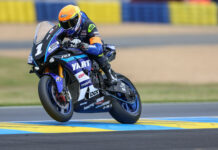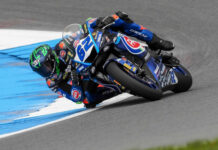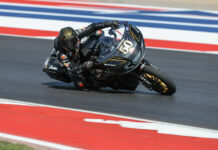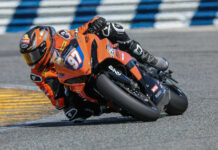Copyright 2005, Roadracing World Publishing, Inc.
FIRST PERSON/OPINION
Via e-mail:
A few other points:
1. There were a number of interesting points raised in the discussion of potential errors related to the measurement of the elapsed time through a speed trap via airplane. I believe one of the most critical factors is the reaction time of the person taking the measurement. Most people at a dragstrip will rarely be under 1/2 a second from the time the light goes from yellow to green until they start, and probably higher. Those who do it professionally get accustomed to the time interval between the ‘christmas tree lights’ and can be under 1/3 second reaction time, but this comes with significant practice. Anticipating when a person will past a line running at over 150 mph can easily be off one side or another, either being early or late, which affect the total time.
2. If, indeed, the rider was accelerating, then assuming the timing was accurate, the rider was probably initially going 150 mph at the start of the quarter mile, and 250 mph at the end of the quarter mile in order to average 205 mph for the 1/4 mile. Therefore the ticket should have been for 250 mph (his highest rate of speed at the end of the quarter mile) not 205 mph.
3. However, the riders absolute speed is closer to 35,000 mph, when you factor in the speed of the earth’s rotation, the speed of the earth’s orbit around the sun, the speed of the solar system around our galaxy, and the speed of the milky way galaxy moving through space. Remember that it is all relative to your own viewpoint and speed. Thus, if two bikes are both going 60 mph in the same direction next to each other, it appears that both are either not moving at all, or moving at the same speed to each other, when in reality they are moving 60 mph to a stationary observer.
4. One final point to ponder:
You need to factor in the speed of light, which is approximately 186,000 miles per second. So, the instant the rider crosses either the start or finish line, there is some delay until the light reaches the pilot. So, when the pilot actuals ‘sees’ the rider cross the line, a few micro or nano seconds have elapsed, and the rider is actually passed the line when the observer ‘sees’ it, assuming instantaneous reaction time of the pilot.
I wonder what kind of tires he was using, and whether they were rated for the supposed speed he was running.. I guess RC51s are a lot faster than we thought.
Fred Ege
Chicago, Illinois
FIRST PERSON/OPINION
Via e-mail:
In all actuality, everyone is still missing the big picture… Regardless of parallax or human/State Trooper error, all of this attention is making this alleged 205-mph, modified (or not) Honda RC51 riding fool into a national folk hero–which he is not!
Officer Michael Oakvik #91
Brooklyn Park Police Department
Brooklyn Park, Minnesota
2003 Honda CBR954RR
FIRST PERSON/OPINION
Via e-mail:
All these PhD’s and they still don’t have it right. The guy was actually doing more like 225 mph but all the donut sugar on the stopwatch made the button stick so the time was actually faster than reported.
Gordon Lunde
Milwaukee, Wisconsin
FIRST PERSON/OPINION
Via e-mail:
I completely agree with the reader who said that anything over 160 mph on public roads is ridiculous. However, this shouldn’t stop us from questioning the accuracy of the speed reading. The reason we should be concerned about this is a PR issue for motorcyclists. The difference between a 3-figure speed starting with a “1” and one that starts with a “2” is dramatic in the minds of the non-motorcycling public. I’d bet that a speed that’s 6% lower (199 mph) would have resulted in far more than 6% fewer articles in mainstream media. In fact, I reckon that a ticket for 199 mph would have resulted in at least 25% fewer articles.
Unfortunately the damage is done and even if it turns out that the guy was doing less than 200 it won’t alter the perceptions of non-motorcyclists who dismiss us all as hooligans.
Neil Smith
San Francisco, California
FIRST PERSON/OPINION
Via e-mail:
Not missing the point:
Jesse Johnson makes a good point that the rider was going too fast whether he was going 160 mph or 205 mph. I certainly wouldn’t disagree with that but the point is that this was made into a huge issue because it’s alleged that he was going 205 mph. If he had been clocked at 160 or so mph, that would not have been that extraordinary. At best it would have made page 4 of the local paper and maybe a personal website. Parallax, Plavix or whatever, the real issue is that the likelihood of an RC51 with mods reaching any speed to warrant the media attention (and negative perception of the non-riding public) that it has is clearly suspect. I for one think that efforts to dispute the validity of the timing is in the interests of anyone who throws a leg over as I fear it won’t be long before some lawmaker tries to build his or her political career around suspect information.
Adrian Chapman
Not a Ph.D. but certainly a rider.
Atlanta, Georgia
FIRST PERSON/OPINION
Via e-mail:
1st: If that RC will do 205 mph I will buy it. I’ll pay the kid’s fine and ship the bike out here to Oregon to race it. Of course, I’m sure I’m not alone in that sentiment and the bidding will probably drive it out of my price range.
2nd: A great deal of noise has been made about possible “human error” or inaccuracies caused by the physics of observation. A few have rightfully pointed out the seeming irrelevance of the exact speed figure based on the “well, he sure as heck was going too fast anyway” argument. I personally feel both miss the silent and more critical point. The officer’s observations are valued based on his impartiality, his experience and his training. All these factors will determine whether his testimony of his observations can be trusted on any level. If the officer has a sworn statement that the kid flew the 1/4 mile 8 inches off the ground, would we waste the breath on an argument that it may have actually been 6 inches off the ground? Would we condemn the kid for the stupidity of flying in a flight restricted zone? Or more likely, would we come to the conclusion that the observation is suspect of being flawed by observer bias. Clearly the officer thinks the bike can go 205 mph, or he would not have written the ticket. His belief prevents him from checking himself from holding whatever bias he has in his observations, and the kid gets a ticket for something he couldn’t have done. The subsequent stop revealed the lack of a motorcycle license, but would he have been stopped without the claim of having been doing 205 mph? The infractions developed from the eventual stop depend on the viability of the premise for the stop; they might just as well have called the bike in for illegal crop dusting.
I expect that this case will eventually be tossed, if not in the lower court then possibly on appeal. That is, unless daddy makes a deal with the judge, to settle on a more realistic charge, to teach Jr. some respect for the law and its repercussions.
No I don’t condone such behavior. Not from either party.
Bill Cismar
OMRRA #7
Vancouver, Washington
FIRST PERSON/OPINION
Via e-mail:
Perhaps Dr. Gaudino should learn how the American court system works. In traffic court (where the ticket would be fought) reasonable doubt is not the standard for disproving the state – that is reserved for criminal cases. In traffic court the defendant must show a preponderance of evidence against the state. Of course it’s all up to the judge, but most traffic court judges could care less about reasonable doubt and will still uphold the ticket. All of Dr. Gaudino’s “human error” arguments would not qualify for a preponderance of evidence and is not a good defense.
Jeff Lind
Portland, Oregon
FIRST PERSON/OPINION
Via e-mail:
A couple of items on the story.
The cop in the plane said he was going about half the speed of the bike and the bike was pulling away from him. So it was accelerating away from him at roughly 100 mph.
I called a couple of the TV stations that aired the story (second item on the evening news). I asked them if they were interested in hearing from someone who races 1000cc bikes why it was very unlikely that this speed was correct. One just wanted to argue and hung up on me when I said “why let relevant facts and physics get in the way of a sensational story?” That was the CBS affiliate. The other asked if it was possible. i told him “yes, it’s possible, but extremely difficult to do under ideal conditions.” He jsut wanted to hear that it was possible. Told me he would call back. They didn’t. Hard to counter bad press when you can’t get a voice.
Basically it’s just a campaign against bikes by the highway patrol. The kid they stopped wasn’t arrested, just ticketed. The reason he wasn’t arrested (and I have never heard of anyone not getting arrested for that type of speed) was that there was a motorcycle run called the Flood Run. It goes up the river from Wisconsin to the Twin Cities. The organizers never say which side of the river to keep the cops guessing, so they wait on both sides of the river. The kid didn’t get arrested cause they didn’t want to lose the manpower when accosting the rest of the bikers.
Marc Chiodo
Minneapolis, Minnesota
FIRST PERSON/OPINION
Via e-mail:
No, I did NOT suggest that parallax would cause a 1 second timing error. That is a statement taken completely out of context. I showed how a half second or 1 second timing error could explain much more reasonable speeds. Then I suggest that parallax can contribute to that timing error.
Ok, I will admit from rereading my original post that I do suggest that Parallax is responsible. But closer inspection of my ENTIRE post will reveal that while I may have misspoken and pointed the focus of the post to parallax, that I spend as much time talking about other factors that could induce timing inaccuracies as I do talking about parallax. Why hasn’t anyone mentioned any of those other factors?
For this I apologize. I do see from the opening of my post that it would be possible to infer that I am suggesting that parallax is the only possible explanation. But its apparent that no one paid any attention to any of the other details I discuss that could have contributed to the error that caused the inaccuracy of the calculated speed.
I mention the effect perspective changes might have on the judging of when to time by suggesting that if the motorcycle were climbing or descending a hill it could also affect the ability to judge when to start or stop the stop watch, depending on the angle the motorcycle is being viewed from while it goes up or down that hill.
I also mention discrepancies in the speeds of the 2 vehicles, which would increase the distance between the plane and motorcycle due to the acceleration of the motorcycle away from the plane occurring at a rate “twice that of the plane” according to the officer interviewed. As the motorcycle accelerated away from the plane by a factor of 2 (according to the officer) the officer timing the event would be even more hard pressed to get the watch stopped at the precise moment. Thus adding more error.
All these could contribute to a timing error. An error that would arise from the officer trying to “get it just right” and maybe “anticipating the crossing of the line”. The real intent of the post was to show how all these factors could cause a significant error from the HUMAN stand point, and how ridiculous the 205 mph citation was. Which is not all that far removed from some of the responses you have been getting. And yes, I do realize that because of the way I started the post, that I’ve asked for the responses I’m getting. However, those same people should review the post in its entirety to see that there are a number of factors mentioned ALL of which could contribute to the error in timing. Just as Dr. Koch’s suggestion that a more likely
“explanation for the error (I don’t believe the guy was doing 205 mph either) is the pilot trying to “time” his reactions to the bike passing either or both markers.”
That’s all I was trying to point out. And once again instead of proving that parallax has NO contribution to the potential timing error, it was shown that it could contribute, albeit in a small way, along with the other factors I mention, to increased human error in the timing event.
I hope that this post will help clarify my original posting. Once again I apologize for sending out a post that was not written clearly enough to express my complete thought process.
Reginald J. Gaudino, Ph.D.
Oceanside, California
FIRST PERSON/OPINION
Via e-mail:
Now that I know that it was an RC51 and not the CBR1000RR, which I think most of us made the mistake assuming it was (thanks to lack of information in the news article), I withdraw all my previous comments.
We all know for sure that an RC51 is the completely correct platform for turbocharging and nitrous oxide induction, and whose cases will routinely withstand 300hp. Therefore I concede that the speed measured by the police officer was indeed correct, and my arguments about timing inaccuracies introduced due to human error based on visual “guesswork” are all out in left field.
My sincere apologies.
(Yes, this is indeed sarcasm.)
Reggie Gaudino, Ph.D.
Oceanside, California
FIRST PERSON/OPINION
Via e-mail:
I think Officer Michael Oakvik #91 is the one missing the big picture. I think many readers have been victimized by an officer of the law who for whatever reason puts down a speed on the ticket that is just plain wrong. I won’t go so far as to say these officers are intentionally misconstruing the truth, but I think they routinely record the speed to the high side in order to make sure the errant rider learns a lesson.
In some cases, when the violation occurs far from home, the rider simply pays the ticket, and deals with the associated insurance hassles. In other cases, the rider may actually have to appear in court at least once, and in at least one case I have specific information on, the arresting officer never showed up and the case was dismissed.
If these officers would simply do their job instead of trying to teach us all a lesson and sensationalizing this in the first place, with tickets written for 205 mph for example, this folk-hero business could be avoided as well.
Bob Setbacken
Santa Barbara, California
If the involved cop hadn’t gone grandstanding in the media, there would be no discussion of the kid wrongly becoming a folk hero, because he wouldn’t have been all over the evening news…Editor.
FIRST PERSON/OPINION
Via e-mail:
I haven’t read all the BS on this, but let me help in the headline department:
“Man Clocked Doing 205 Mph on RC51 While Migratory Swine Fly South For The Winter!”
Tony D’Augusta
WSMC #99
San Diego, California
Updated: Speed Of Light May Have Affected 205-mph Clocking
Updated: Speed Of Light May Have Affected 205-mph Clocking
© 2004, Roadracing World Publishing, Inc.






